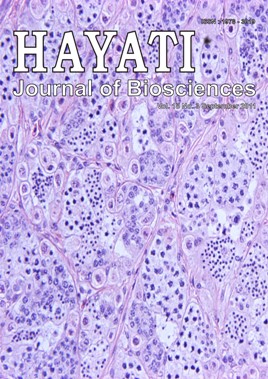<p class="MsoNormal" style="margin-bottom:.0001pt;text-align:justify;text-indent:14.15pt;line-height:normal;"><strong><span style="font-size:9pt;">Mole<span style="color:#000000;">cular marker is useful in the development of testicular cells transplantation for detecting donor-derived germ cells in the recipient gonad. In this study, a giant gourami (<em>Osphronemus goramy</em>) <em>vasa-</em>like gene (GgVLG) was cloned and characterized for use as a molecular marker for germ cells in this species. Nucleotide sequence analysis revealed that GgVLG comprises 2,340 bps with an open reading frame of 1,962 bps encoding 653 amino acids. The deduced amino acid sequence contained 17 arginine-glycine or arginine-glycine-glycine motifs and eight conserved motifs belonging to the DEAD-box protein family. The GgVLG sequence showed high similarity to <em>Drosophila vasa</em>, common carp <em>vasa</em> homolog and tilapia <em>vasa</em> homolog for 66.2, 85.9, and 90.7%, respectively. In adult tissues, the GgVLG transcripts were specifically detected in ovary and testis. <em>In situ</em> hybridization analysis showed that GgVLG mRNA was detected in oocytes of the ovary and spermatogonia of the testis. There was no signal detected in the spermatocytes, spermatids and other gonadal somatic cells. Thus, consensus sequences, specific localization of GgVLG mRNA in the germ cells, amino acid sequence similarity and phylogenic analysis all suggest that GgVLG is the giant gourami <em>vasa-</em>like gene. Further, GgVLG can be used as a molecular marker for giant gourami germ cells.</span></span></strong></p>
Abstract
Molecular marker is useful in the development of testicular cells transplantation for detecting donor-derived germ cells in the recipient gonad. In this study, a giant gourami (Osphronemus goramy) vasa-like gene (GgVLG) was cloned and characterized for use as a molecular marker for germ cells in this species. Nucleotide sequence analysis revealed that GgVLG comprises 2,340 bps with an open reading frame of 1,962 bps encoding 653 amino acids. The deduced amino acid sequence contained 17 arginine-glycine or arginine-glycine-glycine motifs and eight conserved motifs belonging to the DEAD-box protein family. The GgVLG sequence showed high similarity to Drosophila vasa, common carp vasa homolog and tilapia vasa homolog for 66.2, 85.9, and 90.7%, respectively. In adult tissues, the GgVLG transcripts were specifically detected in ovary and testis. In situ hybridization analysis showed that GgVLG mRNA was detected in oocytes of the ovary and spermatogonia of the testis. There was no signal detected in the spermatocytes, spermatids and other gonadal somatic cells. Thus, consensus sequences, specific localization of GgVLG mRNA in the germ cells, amino acid sequence similarity and phylogenic analysis all suggest that GgVLG is the giant gourami vasa-like gene. Further, GgVLG can be used as a molecular marker for giant gourami germ cells.
Downloads
HAYATI J Biosci is an open access journal and the article's license is CC-BY-NC. This license lets others distribute, remix, tweak, and build upon author's work, as long as they credit the original creation. Authors retain copyright and grant the journal/publisher non exclusive publishing rights with the work simultaneously licensed under a https://creativecommons.org/


















.png) IPB University
IPB University Department of Biology
Department of Biology The Indonesian Biological Society
The Indonesian Biological Society 

